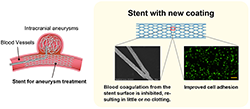|
A researcher in AIST, in collaboration with the Japan Medical Startup Incubation Program (JMPR) and N.B. Medical Corporation, has developed a novel anti-thrombogenic coating for stents used in the treatment of intracranial aneurysms.
In medical devices that come into contact with blood, the control of thrombus formation is an important factor in avoiding serious complications. Because of the placement of foreign bodies in blood vessels, patients with stents are always at risk for thrombotic complications. Therefore, antiplatelet medication is mandatory. Many antithrombotic coatings have been investigated to reduce the risk of thrombus formation. The principle of conventional coatings is that they exhibit antithrombotic properties by inhibiting nonspecific adsorption of plasma proteins. However, the inhibition of protein adsorption also means inhibition of cell adhesion. Therefore, although the antithrombogenicity is improved, the cell adhesiveness is accordingly decreased in conventional coating technology.
Recently, we have found an anti-thrombogenic coating with a new principle. This technology preferentially captures non-coagulant proteins in the blood, thereby inhibiting the blood coagulation reaction from the stent surface due to the blocking effect. This technology, which controls rather than inhibits the protein adsorption, provides anti-thrombogenic properties while simultaneously is able to improve the cell adhesion. The improved cell adhesion can accelerate the coverage of the stent with the vessel. The early coverage of the stent with the vessel means earlier completion of the stent therapy.
This technology reduces the occurrence of thrombotic complications, which have been an issue with stent therapy. Furthermore, it enables reduction of the treatment period, and thereby, the amount of antiplatelet drug use can be lower, which not only reduces the burden on patients, but also contributes to the medical cost cut.
The details of this technology were published in Scientific Reports on July 10, 2024.
|

|